Paris France - Arc de Triomphe
| bottom |
Homepage Feedback? Enter your comments in the guest book |
Bavaria | |
| Previous | Back to Travelogue | Next |
11 of 15 |
|
Click on any picture to bring up the picture enlarged in a new window |
|||
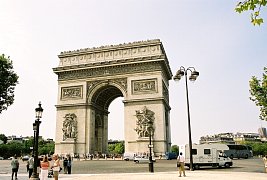 Here is the Arc de Triomphe. Commissioned in 1806 by Napoleon, shortly after
his victory at Austerlitz, it was not finished until 1836.
He envisioned that his victorious troops would march through the arch cheered
by the population of
Paris. This never happened thanks to the defeat of Napoléon at
Waterloo in 1815.
There are four huge
relief sculptures at the bases of the four pillars. These commemorate The
Triumph of 1810 (Cortot); Resistance , and Peace (both by Etex); and The
Departure of the Volunteers, more commonly known by the name La Marseillaise (Rude).
Here is the Arc de Triomphe. Commissioned in 1806 by Napoleon, shortly after
his victory at Austerlitz, it was not finished until 1836.
He envisioned that his victorious troops would march through the arch cheered
by the population of
Paris. This never happened thanks to the defeat of Napoléon at
Waterloo in 1815.
There are four huge
relief sculptures at the bases of the four pillars. These commemorate The
Triumph of 1810 (Cortot); Resistance , and Peace (both by Etex); and The
Departure of the Volunteers, more commonly known by the name La Marseillaise (Rude).
|
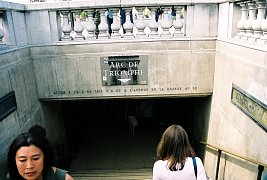 The Arc de Triomphe is in a square formed
where the
Champs Elysées, the Avenue Foch, the Avenue de la Grande Armée and nine
other avenues come together (twelve avenues). You have to go down through a
tunnel in order to go under the street and reach the square.
The Arc de Triomphe is in a square formed
where the
Champs Elysées, the Avenue Foch, the Avenue de la Grande Armée and nine
other avenues come together (twelve avenues). You have to go down through a
tunnel in order to go under the street and reach the square.
|
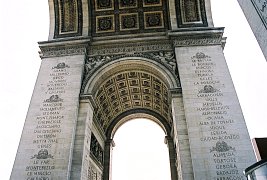 On
14 July - the French National Day (refereed to as Bastille Day everywhere except
in France) - a military parade down the Champs Elysées begins here. For important
occasions of state, and national holidays, a huge French tricolor is unfurled and
hung from the vaulted ceiling inside of the Arch. At the top of the arch are 30 shields,
each of them bears the name of one of Napoleon's
successful battles. You can make out six of them here.
On
14 July - the French National Day (refereed to as Bastille Day everywhere except
in France) - a military parade down the Champs Elysées begins here. For important
occasions of state, and national holidays, a huge French tricolor is unfurled and
hung from the vaulted ceiling inside of the Arch. At the top of the arch are 30 shields,
each of them bears the name of one of Napoleon's
successful battles. You can make out six of them here.
|
 The names of less important victories,
as well as those of 558 generals, are to found on the inside walls. Generals
whose names are underlined died in action.
Here is a link as of
1/12/2004 that shows them - the underlined ones died in battle
Generals of Napoleon I
The names of less important victories,
as well as those of 558 generals, are to found on the inside walls. Generals
whose names are underlined died in action.
Here is a link as of
1/12/2004 that shows them - the underlined ones died in battle
Generals of Napoleon I
|
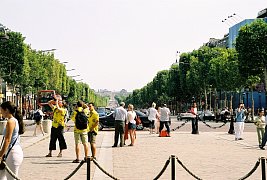 A look back down the Champs Elysées (where we came from).
A look back down the Champs Elysées (where we came from).
|
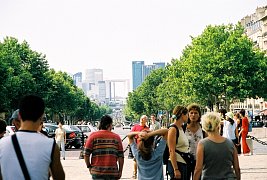 A look up another avenue to the Grande Arch de la Defense.
A look up another avenue to the Grande Arch de la Defense.
|
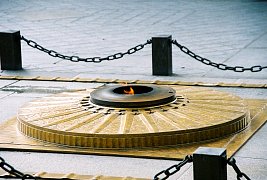 Beneath the Arch is the Tomb of the Unknown Soldier, and eternal flame
commemorating the dead of the two world wars.
Here every Armistice Day (11 November) the President of the Republic lays a wreath.
The eternal flame at JFK's grave
in Arlington National cemetery is modelled after this flame.
Beneath the Arch is the Tomb of the Unknown Soldier, and eternal flame
commemorating the dead of the two world wars.
Here every Armistice Day (11 November) the President of the Republic lays a wreath.
The eternal flame at JFK's grave
in Arlington National cemetery is modelled after this flame.
|
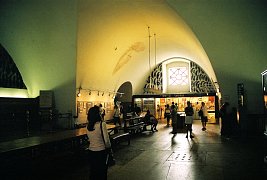
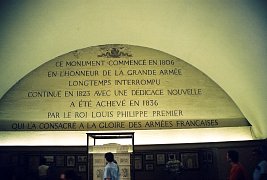 Inside the Arch there is a small museum documenting its history and construction.
There are many steps to climb to the top - the museum is about half way there.
I think an elevator is available, but am not sure.
Inside the Arch there is a small museum documenting its history and construction.
There are many steps to climb to the top - the museum is about half way there.
I think an elevator is available, but am not sure.
|
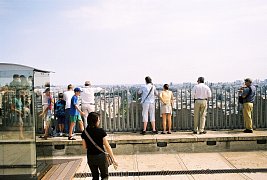
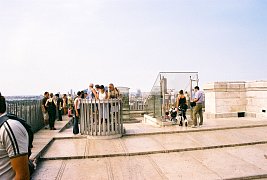
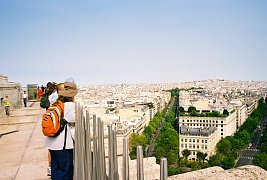
|
| This is what it's like to approach the edge. There are multiple levels here on the top so remember to watch where you are walking. It's pretty easy to get distracted by the view. |
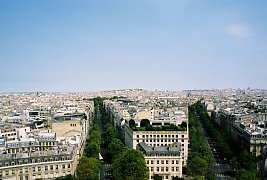
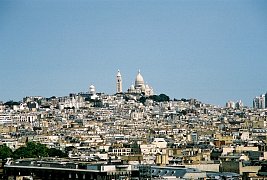 Many avenues spread out in all directions from the Arc. Sacre Coeur is visible in
the background. Located on a little hill, Sacre Coeur catches your eye from every
other high spot in Paris.
Many avenues spread out in all directions from the Arc. Sacre Coeur is visible in
the background. Located on a little hill, Sacre Coeur catches your eye from every
other high spot in Paris.
|
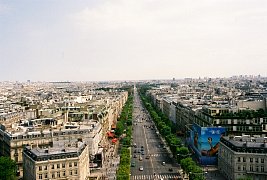 The view the Champs Elysée back toward the Obelisk of Luxor.
The view the Champs Elysée back toward the Obelisk of Luxor.
|
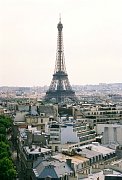
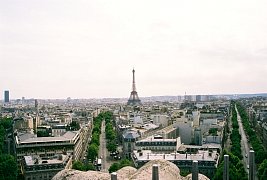 These shots give you an idea of the area near where the Eiffel Tower is located.
These shots give you an idea of the area near where the Eiffel Tower is located.
|
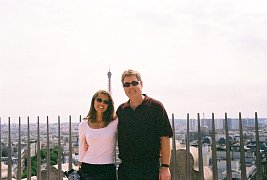 Here we are with the Eiffel Tower in the background.
Here we are with the Eiffel Tower in the background.
|
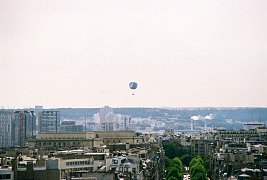 This balloon over of Paris caught my eye. The first manned hot air
balloon flight
took place in Paris on November 21, 1783. Two champagne-toting
noblemen, Joseph and Etienne Montgolfiers floated for twenty minutes
from one side of the Siene to
the other. They landed and popped their corks in triumph. The American Benjamin
Franklin helped finance and witnessed the first hydrogen balloon on December 1 the same year.
The balloon, piloted by Jacques Charles took off near the Jardin de Tuileries and
few 27 miles in two hours.
This balloon over of Paris caught my eye. The first manned hot air
balloon flight
took place in Paris on November 21, 1783. Two champagne-toting
noblemen, Joseph and Etienne Montgolfiers floated for twenty minutes
from one side of the Siene to
the other. They landed and popped their corks in triumph. The American Benjamin
Franklin helped finance and witnessed the first hydrogen balloon on December 1 the same year.
The balloon, piloted by Jacques Charles took off near the Jardin de Tuileries and
few 27 miles in two hours.
|
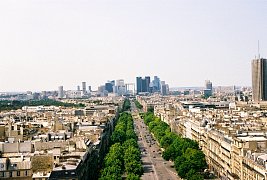
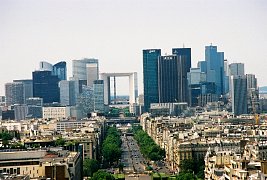 These last two shots are looking off into the distance at the Grande Arch de la Defense
Ever wonder why there are no skyscrapers in the older center of Paris? The
ground underneath has many mine shafts and caves cut into it over the years. The
ground will simply not support the tremendous weight of a skyscraper. That's
why those buildings appear only on the outskirts of the old city.
These last two shots are looking off into the distance at the Grande Arch de la Defense
Ever wonder why there are no skyscrapers in the older center of Paris? The
ground underneath has many mine shafts and caves cut into it over the years. The
ground will simply not support the tremendous weight of a skyscraper. That's
why those buildings appear only on the outskirts of the old city.
|
| top |
Homepage Feedback? Enter your comments in the guest book |
Bavaria | |
| Previous | Back to Travelogue | Next |
11 of 15 |
|
Click on any picture to bring up the picture enlarged in a new window |
|||